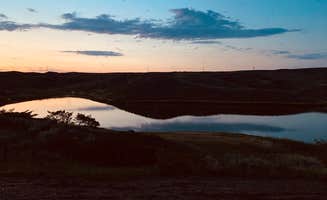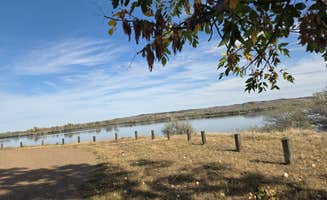Fort Peck Lake dominates the camping landscape near Nashua, Montana, with several primitive camping areas situated along its 1,520-mile shoreline. The region sits at approximately 2,200 feet elevation, experiencing hot summers with temperatures reaching 90°F and cold winters often well below freezing. Summer thunderstorms can develop quickly over the lake, creating challenging conditions for campers without proper shelter.
What to do
Fishing opportunities: Fort Peck Lake offers excellent fishing for walleye, northern pike, and smallmouth bass. Flat Lake Recreation Area provides direct lake access for anglers. "This is a free 14-day boondocking area on a beautiful lake. It's not a free for all, but rather there are a few areas you can camp," notes camper Joni Z.
Dam exploration: Visit the Fort Peck Dam, which created Montana's largest reservoir. Roundhouse Point Campground offers proximity to this engineering marvel. The campground is "very near the dam and interpretive center," according to reviewer Tee C., making it convenient for educational outings.
Birding trails: The area surrounding Nashua supports diverse bird populations, especially during migration seasons. Waterfowl, shorebirds, and raptors frequent the shorelines and nearby fields. Bring binoculars and field guides to identify local species from your campsite.
What campers like
Spacious lakefront sites: The primitive camping areas around Nashua provide ample room between campsites. A camper describes Flat Lake Recreation Area as having "concrete picnic tables and fire rings" with sites spread across the area rather than tightly packed together.
Quiet atmosphere: Despite being free camping areas, these sites typically maintain a peaceful environment, especially on weekdays. "Beautiful quiet camping by the lake" is how one visitor characterized Duck Creek, highlighting the tranquil setting many campers seek.
Basic amenities: Though primitive, many sites include essential facilities. "Vault toilets, plenty of sites, really nice! Picnic tables, fire pits," notes a camper about Roundhouse Point, indicating the basic comforts available at dispersed sites in the region.
What you should know
Road conditions: Access roads to primitive camping near Nashua vary seasonally. After rain, some areas become challenging to navigate. One visitor to Flat Lake noted: "It was pretty quiet on a Sunday night but it looked like there were a lot of folks on the weekend based on the deep tracks in the mud."
Limited facilities: Bring everything you need, including drinking water. None of the dispersed camping areas provide potable water, electricity, or shower facilities. Most do have vault toilets and some garbage collection.
Seasonal closures: Winter conditions often make access difficult or impossible from November through April. Spring melt can create muddy conditions that persist into early summer at Roundhouse Point Campground.
Tips for camping with families
Wildlife viewing opportunities: The lake shoreline attracts various wildlife, making for excellent nature observation with children. Bring binoculars and wildlife identification books to engage younger campers.
Prepared activities: Cell service is generally reliable, but entertainment options are limited. Pack games, fishing equipment, and nature exploration kits for children to prevent boredom during longer stays.
Safety considerations: The lake can experience sudden weather changes. "Garbage cans and vault toilets" are available at Flat Lake according to a reviewer, but emergency services are distant, so maintain awareness of weather forecasts and keep a well-stocked first aid kit.
Tips from RVers
Levelness varies: Bring leveling blocks as primitive camping sites around Nashua typically aren't graded. Most areas can accommodate larger vehicles, with Flat Lake specifically noted as "big-rig-friendly" in the amenities list.
Boondocking preparation: No hookups exist at any dispersed camping areas near Nashua. RVers should arrive with full water tanks and empty waste tanks. One camper at Flat Lake Recreation Area described it specifically as a "boondocking area," confirming the need for self-sufficiency.
Spacing between sites: While these areas can get busy on weekends, they typically offer adequate space for larger rigs. "Gorgeous and spacious" is how one RVer described the layout, indicating room for slides and awnings without crowding neighboring campers.



